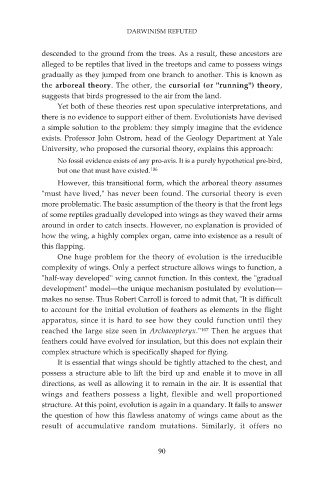Page 92 - Darwinism Refuted
P. 92
DARWINISM REFUTED
descended to the ground from the trees. As a result, these ancestors are
alleged to be reptiles that lived in the treetops and came to possess wings
gradually as they jumped from one branch to another. This is known as
the arboreal theory. The other, the cursorial (or "running") theory,
suggests that birds progressed to the air from the land.
Yet both of these theories rest upon speculative interpretations, and
there is no evidence to support either of them. Evolutionists have devised
a simple solution to the problem: they simply imagine that the evidence
exists. Professor John Ostrom, head of the Geology Department at Yale
University, who proposed the cursorial theory, explains this approach:
No fossil evidence exists of any pro-avis. It is a purely hypothetical pre-bird,
but one that must have existed. 106
However, this transitional form, which the arboreal theory assumes
"must have lived," has never been found. The cursorial theory is even
more problematic. The basic assumption of the theory is that the front legs
of some reptiles gradually developed into wings as they waved their arms
around in order to catch insects. However, no explanation is provided of
how the wing, a highly complex organ, came into existence as a result of
this flapping.
One huge problem for the theory of evolution is the irreducible
complexity of wings. Only a perfect structure allows wings to function, a
"half-way developed" wing cannot function. In this context, the "gradual
development" model—the unique mechanism postulated by evolution—
makes no sense. Thus Robert Carroll is forced to admit that, "It is difficult
to account for the initial evolution of feathers as elements in the flight
apparatus, since it is hard to see how they could function until they
reached the large size seen in Archaeopteryx." 107 Then he argues that
feathers could have evolved for insulation, but this does not explain their
complex structure which is specifically shaped for flying.
It is essential that wings should be tightly attached to the chest, and
possess a structure able to lift the bird up and enable it to move in all
directions, as well as allowing it to remain in the air. It is essential that
wings and feathers possess a light, flexible and well proportioned
structure. At this point, evolution is again in a quandary. It fails to answer
the question of how this flawless anatomy of wings came about as the
result of accumulative random mutations. Similarly, it offers no
90

